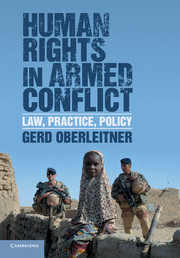Book contents
- Frontmatter
- Contents
- Acknowledgments
- Table of cases
- Table of Legal Instruments
- List of Abbreviations
- Introduction
- Part I Human rights in armed conflict: history of an idea
- 1 From medieval sources to modernity
- 2 The science of warfare and the progress of civilization
- 3 1945: whither war?
- 4 Human rights in armed conflict
- Part II Human rights and humanitarian law: theory
- Part III Human rights and humanitarian law: challenges and commonalities
- Part IV The dynamics of war and law
- Part V Enforcement: practice and potential
- Conclusion
- Bibliography
- Index
- References
2 - The science of warfare and the progress of civilization
Published online by Cambridge University Press: 05 March 2015
- Frontmatter
- Contents
- Acknowledgments
- Table of cases
- Table of Legal Instruments
- List of Abbreviations
- Introduction
- Part I Human rights in armed conflict: history of an idea
- 1 From medieval sources to modernity
- 2 The science of warfare and the progress of civilization
- 3 1945: whither war?
- 4 Human rights in armed conflict
- Part II Human rights and humanitarian law: theory
- Part III Human rights and humanitarian law: challenges and commonalities
- Part IV The dynamics of war and law
- Part V Enforcement: practice and potential
- Conclusion
- Bibliography
- Index
- References
Summary
The positivist nineteenth century
When the European geopolitical landscape was restructured after the Congress of Vienna of 1815, innovations in the law and policy of warfare could take hold and the law of war was resuscitated. The nineteenth century was an era of belief in human evolution and technical advances. Scientific progress was everywhere and warfare itself became a science. In terms of law, this was a positivist century in which the rules on warfare – hitherto scattered over customary principles, religious teaching, domestic laws and military manuals – could finally be consolidated under the rubric of public international law. Not only did international law provide the structure within which warfare was now regulated but the whole of international law became decisively shaped and developed by regulations for, in and around war. The law of war was finally decoupled from considerations of justice and the spirit of the century also meant that the new norms on warfare turned out to be highly technical norms, informed by the technological advances of the time and created in a scientific perception of the law by nation states at the prime of their sovereignty. The positivism of this century did away with divine or “metaphysical” justifications of legal rules and sought to establish law as an objective science. At the same time, it also promoted a realist and functional view of the law as an instrument to further the interests of each individual nation state rather than any illusory international community.
The rules on warfare drafted in this spirit were state-centred, practical and technocratic rules driven by utilitarian considerations. While tempered by occasional references to humanitarian considerations, neither morale and values nor the idea of any such thing as an “international community” provided guidance in the development of the law. Peace and war could also be strictly separated: “peace was a condition in which war was absent, and war a condition in which peace was absent.” This prevailing approach was only intermittently challenged by more liberal and cosmopolitan views which preserved the legacy of the Enlightenment, believed in individual rights and expressed empathy for non-European peoples.
- Type
- Chapter
- Information
- Human Rights in Armed ConflictLaw, Practice, Policy, pp. 24 - 37Publisher: Cambridge University PressPrint publication year: 2015

